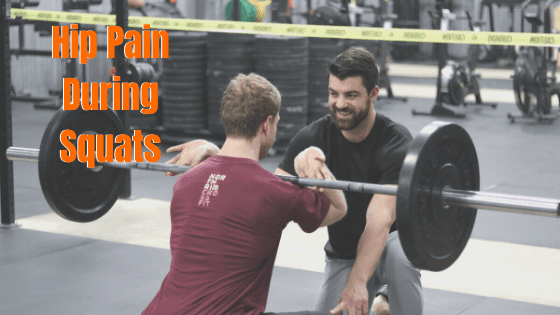
Zach Long here, Doctor of Physical Therapy, talking about the best stretches for dealing with hip pain during your squats. This is often referred to as femoracetabular impingement or hip impingement. This is something that we very commonly treat, especially with CrossFitters, powerlifters and Olympic lifters. These two stretches outline below (and in the video above) will help you reduce hip pain and increase mobility.
Stretch 1: Ankle Mobility
The first stretch we recommend is actually not even a hip stretch – but an ankle stretch. The reason for this is that a lot of individuals will go through a lot of hip motion as they squat. In other words, they don’t get their knees to push forward very much. They end up pinching in the front side of their hips. So, if we can shift them from being a little bit more hip dominant in their squat to getting knees forward, that decreases the amount of hip motion necessary to reach the bottom of a squat. This can be a game changer for those with femoracetabular impingement.
So the way you’re going to do this stretch is to grab a kettlebell or a dumbbell. Next, rest your forearms right above our knees and then drop down into a squat. From here, let that kettlebell pull the knees forward so we’re actually stretching the ankles to improve a little bit of ankle dorsiflexion mobility. When doing this stretch, work on keeping more of an upright torso in the bottom of a squat.
Stretch 2: Hip Mobility
The second stretch is really good to actually get after the hip and stretch the posts of the back of your hip, the backside of the hip. You’ve probably done the pigeon stretch already if you’re dealing with hip impingement. This is going to be different and more effective for you.
The way we set up this stretch is on our hands and knees. Say my right leg is the leg dealing with some hip impingement symptoms. I’m going to kick my left leg back and have most of my weight going through my right knee. Then I’m going to rotate my right foot in and shift my hips towards the right side. Right there I’m starting to feel a little bit of tension in the backside of my hip, but I’m really going to turn that up by sitting back. As I sit back you’ll see I won’t have to go very far to feel a big stretch in the back of my hip that’s really deep, deeper than you’ll typically feel something like the pigeon stretch. We’ll just hang out here for a minute or two, working to stretch the back side of that hip capsule.
Now with that stretch, you can play around with a couple of different things. You can play around with how much rotation you use, how much side bending you use, and how much you go into hip flexion to really get that good backside stretch. What I don’t want to happen is for you to get deep into hip flexion as you do the stretch. I’d rather you get a little more tied up with the rotation or in the side glide instead. This is because hip flexion (where we bring the knee towards the chest) tends to be a position that turns on symptoms for a lot of people dealing with hip impingement. We don’t want that to happen with this stretch, just that big backside stretch.
Both of these stretches are fantastic to help with hip impingement or hip pinching during your squats.
Ready for more help with your femoracetabular impingement? Schedule an appointment today to get on the road to recovery!
Recent Articles
Why Early Intervention Physical Therapy Accelerates Your Recovery

What to Expect at Your First Physical Therapy Session?

How to Choose a Physical Therapist

The Top 5 Misconceptions About Physical Therapy

The Complete Guide to Physical Therapy

